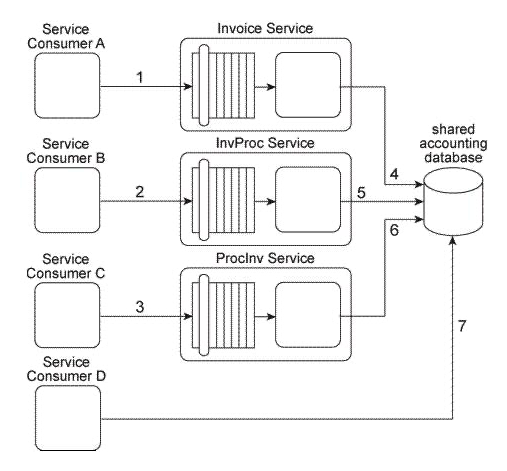Our service inventory contains the following three services that provide invoice-related data access capabilities: Invoice, InvProc, and Proclnv. These services were created at different times by different project teams and were not required to comply to any design standards. Therefore each of these services has a different data model for representing invoice data. Currently each of these three services has one service consumer: Service Consumer A accesses the Invoice service(1) . Service Consumer B (2) accesses the InvProc service, and Service Consumer C (3) accesses the Proclnv service. Each service consumer invokes a data access capability of an invoice-related service, requiring that service to interact with the shared accounting database that is used by all invoice-related services (4, 5, 6) . Additionally, Service Consumer D was designed to access invoice data from the shared accounting database directly (7) . (Within the context of this architecture. Service Consumer D is labeled as a service consumer because it is accessing a resource that is related to the illustrated service architectures.)  A project team recently proclaimed that it has successfully applied the Contract Centralization pattern to the service inventory in which the Invoice service, InvProc service, and ProcInv service reside. Upon reviewing the previously described architecture you have doubts that this is true. After voicing your doubts to a manager, you are asked to provide specific evidence as to why the Contract Centralization is not currently fully applied. Which of the following statements provides this evidence?
A project team recently proclaimed that it has successfully applied the Contract Centralization pattern to the service inventory in which the Invoice service, InvProc service, and ProcInv service reside. Upon reviewing the previously described architecture you have doubts that this is true. After voicing your doubts to a manager, you are asked to provide specific evidence as to why the Contract Centralization is not currently fully applied. Which of the following statements provides this evidence?
Definitions:
Q25: Fill in the blank for the following
Q27: The Service Discoverability principle is supported by
Q45: I anticipate building larger service compositions comprised
Q49: According to SNIA, what is a data
Q49: Which of the following statements is true?<br>A)
Q56: The Invoice service in an accounting firm
Q66: You have twelve 500 GB drives and
Q99: Evidences the fair market value of the
Q138: Mutual entities, reciprocal or inter-insurance exchanges, public
Q189: What technique uses a risk-adjusted discount rate